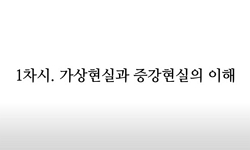이 글은 고고학과 가상현실(VR)의 교차점에 대해 논의하며, 주로 해외 사례에 초점을 맞추고 있다. 또 한 이 글은 가상현실이 고고학 발굴, 연구, 해석, 의사소통에 새로운 방법을 제공하는 방...
http://chineseinput.net/에서 pinyin(병음)방식으로 중국어를 변환할 수 있습니다.
변환된 중국어를 복사하여 사용하시면 됩니다.
- 中文 을 입력하시려면 zhongwen을 입력하시고 space를누르시면됩니다.
- 北京 을 입력하시려면 beijing을 입력하시고 space를 누르시면 됩니다.
https://www.riss.kr/link?id=A109045973
- 저자
- 발행기관
- 학술지명
- 권호사항
-
발행연도
2024
-
작성언어
Korean
-
주제어
가상현실 ; 3D 시각화 ; 3D 모델링 ; 대중고고학 ; 사회교육 ; Virtual Reality ; 3D Visualization ; 3D Modeling ; Public Archaeology ; Social Education
-
KDC
911
-
등재정보
KCI등재
-
자료형태
학술저널
-
수록면
141-169(29쪽)
- 제공처
-
0
상세조회 -
0
다운로드
부가정보
국문 초록 (Abstract)
이 글은 고고학과 가상현실(VR)의 교차점에 대해 논의하며, 주로 해외 사례에 초점을 맞추고 있다. 또 한 이 글은 가상현실이 고고학 발굴, 연구, 해석, 의사소통에 새로운 방법을 제공하는 방식에 대해 논의한다. 가상현실이 고고학자가 고고학 유구와 유물의 3D 모델을 만들고 조작하게 하고, 가상현실 환경 내에서 변수나 조건을 변경하여 다양한 이론과 가설을 테스트하게 하며, 시간에 따른 변화를 시뮬레이션하여 고고학 유적과 경관이 어떻게 변화했는지 관찰하게 하는 방식에 대해 강조한다. 또한 논문은 시각적 인식뿐만 아니라 인지도 포함된 이미지를 보는 과정의 개념을 강조한다. 이는 우리가 이미지를 볼 때 시각적 정보를 수동적으로 받아들이는 것이 아니라, 우리의 뇌가 이 정보를 적극적으로 처리하여 우리가 인식하고, 생각하고, 결정을 내리도록 유도한다는 것을 의미한다. 이는 시각적 의사소통의 중요성을 강조하며, 3D 모델이나 유적의 상세 3D 맵을 보여주면 사용자는 즉시 다양한 유구의 형태와 상대적 위치를 파악할 수 있다. 또한 가상현실과 고고학의 교차점을 탐구하며, 이를 통해 고고학 유구와 유물의 3D 모델링, 가상현실 환경에서의 이론 및 가설 테스트, 고고학 유적의 시간에 따른 변화에 대한 시뮬레이션 등 다양한 측면을 제시한다. 그리고 가상현실이 고고학적 데이터 분석을 넘어서 더 많은 작업으로 확장될 수 있음을 보여준다. 이는 고고학자로 하여금 고고학 유구나 유물의 3D 모델과 상호작용하고 시간에 따른 변화를 관찰할 수 있게 하므로, 이 데이터를 보다 몰입적이고 직관적인 방식으로 분석할 수 있게 한다. 이와 더불어 3D 환경 개발에서 고고학적, 역사학적 정확성의 중요성 또한 강조한다. 런던 헌장과 세비야 원칙 등 국제적인 기준들이 문화유산의 3D 시각화에 대한 지침을 제공하며, 이러한 기준들은 고고학 데이터의 불확실성을 인정하고 이를 고려하여 3D 모델을 생성하는 것을 요구한다. 또한 실제 데이터와 가설 데이터를 명확히 구분하고, 이를 통해 과거의 특정 시대나 지역을 더욱 사실적으로 표현하는 가상현실 환경을 구축하는 방법을 제시한다. 이는 가상현실 환경의 진정성을 보장하고, 사용자에게 이 시대의 역사에 대한 교육적 가치를 제공하는 데 도움이 될 것이다.
다국어 초록 (Multilingual Abstract)
This article discusses the intersection of archaeology and virtual reality (VR), focusing primarily on international cases. It also discusses how virtual reality provides new methods for archaeological excavation, research, interpretation, and communi...
This article discusses the intersection of archaeology and virtual reality (VR), focusing primarily on international cases. It also discusses how virtual reality provides new methods for archaeological excavation, research, interpretation, and communication. Virtual reality allows archaeologists to create and manipulate 3D models of archaeological artifacts and relics, change variables or conditions within a virtual reality environment to test various theories and hypotheses, and simulate changes over time to observe how archaeological sites and landscapes have changed. The paper also emphasizes the concept of viewing images that include not only visual perception but also cognition. This means that when we look at images, we do not passively receive visual information, but our brains actively process this information to induce us to perceive, think, and make decisions. This emphasizes the importance of visual communication, and when users are shown 3D models or detailed 3D maps of relics, they can immediately grasp the various forms and relative positions of the relics. It also explores the intersection of virtual reality and archaeology, presenting various aspects through this, such as 3D modeling of archaeological relics and artifacts, theory and hypothesis testing in a virtual reality environment, and simulation of changes in archaeological sites over time. It also shows that virtual reality can be extended to more tasks beyond archaeological data analysis. This allows archaeologists to interact with 3D models of archaeological relics or artifacts and observe changes over time, allowing them to analyze this data in a more immersive and intuitive way. It also emphasizes the importance of archaeological and historical accuracy in 3D environment development. International standards such as the London Charter and Seville Principles provide guidelines for 3D visualization of cultural heritage, and these standards require the recognition of the uncertainty of archaeological data and the creation of 3D models considering this. It also clearly distinguishes between actual data and hypothetical data, and presents a way to build a virtual reality environment that more realistically represents a specific era or region of the past. This ensures the authenticity of the virtual reality environment and will help provide educational value about the history of this era to users.
목차 (Table of Contents)
- 국문초록
- Ⅰ. 머리말
- Ⅱ. 가상현실의 개념
- Ⅲ. 가상현실 고고학의 개념
- Ⅳ. 가상현실 고고학의 구성 요소
- 국문초록
- Ⅰ. 머리말
- Ⅱ. 가상현실의 개념
- Ⅲ. 가상현실 고고학의 개념
- Ⅳ. 가상현실 고고학의 구성 요소
- 1. 데이터 획득 및 처리
- 2. 분석
- 3. 디지털 환경에서의 시뮬레이션
- 4. 의사소통 수단으로서의 3D 복원
- Ⅴ. 사례 연구
- 1. 캐나다 퀘벡시에서 발굴된 식민지 감독관의 거처인 궁전유적(intendant’s p alace)
- 2. 광산 유적
- Ⅵ. 맺음말
- 참고문헌
- Abstract
동일학술지(권/호) 다른 논문
-
- 한국문화유산협회
- 윤태웅
- 2024
- KCI등재
-
이식 쿠르간 금제 장식의 제작기법과 기술문화사 상 의의
- 한국문화유산협회
- 김동균
- 2024
- KCI등재
-
호남지역 원삼국~삼국시대 보온 및 난방에관한 일고찰 - 주거 자료를 중심으로 -
- 한국문화유산협회
- 김은정
- 2024
- KCI등재
-
- 한국문화유산협회
- 최정범
- 2024
- KCI등재





 eArticle
eArticle






